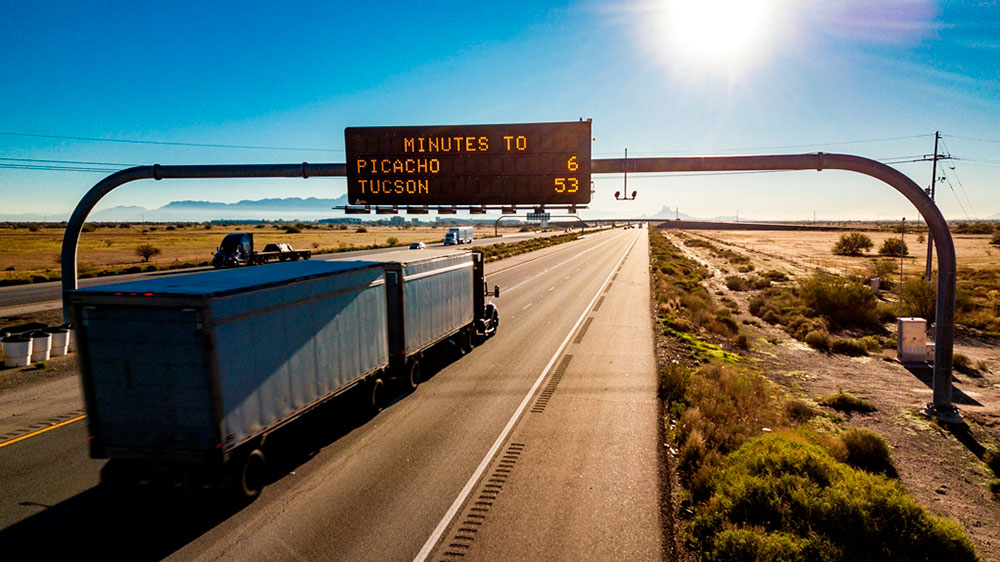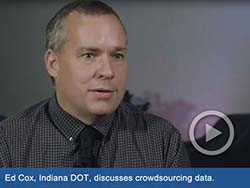February 20, 2020
Innovation of the Month:
Crowdsourcing for Operations
Last week, we discussed how crowdsourcing for operations helped the Missouri Department of Transportation (MDOT) with traffic incident management and prioritizing maintenance needs. Providing real-time traveler information is another important application crowdsourcing can help agencies improve upon. This is especially true in rural areas where traffic detectors are more sparsely located.
The Arizona Department of Transportation's (ADOT) "travel times program" is a good example of how crowdsourced data can improve real-time traveler information. ADOT has displayed travel times on a limited number of dynamic message signs (DMS), primarily in the Phoenix area, for over a decade. The availability of crowdsourced data, however, has allowed ADOT to expand this practice to routes and signs on rural freeways statewide.

Traditionally, travel times are determined from infrastructure-based traffic detectors embedded in the pavement or along the side of the roadway. Data quality and accuracy from the detectors is a persistent issue and requires the department to monitor and maintain the detectors frequently.
To provide more accurate travel times, ADOT developed a system to automatically collect real-time vehicle speed data from a third-party provider who collects anonymized "probe" data from mobile phones, connected cars, trucks, delivery vans, and other fleet vehicles equipped with GPS devices. Once collected and stored in a database, the data is processed, and the travel times are formatted and sent to the DMS using a third-party application.
This system allows ADOT to post travel times to 94 rural DMS across the state without the expense and time needed to install and maintain additional traffic detectors and associated communications systems. ADOT also created a user interface with various views, including a travel times home page showing all DMS and their current messages, and a map view of the DMS and associated messages.
To learn more about how your agency can use crowdsourced data to improve traveler information, please contact James Colyar or Paul Jodoin of the Federal Highway Administration Office of Operations.
EDC Outtakes – Crowdsourcing for Operations
In EDC Outtakes—a series of short interview videos—State practitioners and FHWA personnel give insight into the current round of EDC innovations. In our latest edition, Ed Cox, director of engineering for the Indiana Department of Transportation Traffic Management Group, discusses how INDOT gets crowdsourced data in a similar way as Arizona's travel times program. Probe data from a third party gives INDOT average roadway speeds for 6,000 interstate highway segments every 60 seconds to identify slowdowns on the roadway, put up messages on dynamic messaging signs, update websites, and alert responders.
Keep reading EDC News for future editions of EDC Outtakes!
AID Demo and STIC Projects Highlighted in UDOT Innovations Report
The Utah Department of Transportation recently released its annual innovations report. The report provides a snapshot of activities that align with UDOT's Mission: "Innovating transportation solutions that strengthen Utah's economy and enhance quality of life."
The report highlights UDOT's use of STIC Incentive and AID Demonstration funding as a catalyst for innovation and describes the new continuous improvement cycle program to improve statewide operational efficiencies. Utah is using STIC Incentive funding to advance the use of e-ticketing for asphalt delivery ticket collection and quantity calculation, piloting 7 projects with more project planned for this year. Utah also used AID Demonstration funding to advance digital delivery of model based design and construction. They created a repeatable process to use the same model from design to construction and have delivered 11 projects with the model as the legal document.
For more information on Utah's use of innovative technologies, please contact Ryan Bailey or Rod McDaniels with UDOT.
About EDC
Every Day Counts, a State-based program of the Federal Highway Administration’s Center for Accelerating Innovation, works with State, local, and private sector partners to encourage the adoption of proven technologies and innovations to shorten and enhance project delivery.



